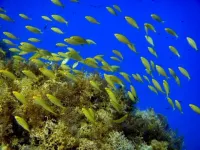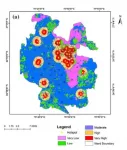DNA--Metal double helix
Single-stranded DNA as supramolecular template for highly organized palladium nanowires
2021-03-26
(Press-News.org) Nanowires are vital components for future nanoelectronics, sensors, and nanomedicine. To achieve the required complexity, it is necessary to control the position and growth of the metal chains on an atomic level. In the journal Angewandte Chemie, a research team has introduced a novel approach that generates precisely controlled, helical, palladium-DNA systems that mimic the organization of natural base pairs in a double-stranded DNA molecule.
A team from Europe and the USA led by Miguel A. Galindo has now developed an elegant method for producing individual, continuous chains of palladium ions. The process is based on self-organized assembly of a special palladium complex and single-stranded DNA molecules.
In recent years, DNA has become an important tool for nanoscience and nanotechnology, particularly because of the possibility of "programming" the resulting structures through the base sequence of the DNA used. The incorporation of metals in DNA structures can give them properties such as conductivity, catalytic activity, magnetism, and photoactivity.
However, organizing metal ions in DNA molecules is not trivial because metal ions can bind to many different sites. Galindo's team developed a smart method for controlling the binding of palladium ions to specific sites. They use a specially constructed palladium complex that can form base pairs with natural adenine bases in a strand of DNA. The ligand in this complex is a flat, aromatic ring system that grasps three of the four binding positions available on the palladium ion. The fourth position of the palladium is then available to bind to a very specific nitrogen atom in adenine. The ligand also possesses oxygen atoms capable of forming a hydrogen bond with the neighboring NH(2) group of the adenine. This binding pattern corresponds exactly to a Watson-Crick base pairing, but now mediated by a palladium ion, which makes it considerably stronger than natural Watson-Crick pairing.
If a DNA strand made exclusively of adenine bases is used, one palladium complex binds to each adenine. The flat ligands assemble themselves into coplanar stacks, just like natural bases. This results in a double strand made of DNA and palladium complexes that corresponds to a natural DNA double helix in which one strand has been replaced by a supramolecular stack of continuous palladium complexes.
Although the team has yet to demonstrate the conductive properties of these systems, it can be anticipated that the correct reduction of these metal ions could lead to the formation of a conductive nanowire with a highly controlled structure. The research group is currently working in this line as well as in the modification of the ligand, which can also provide new properties to the system.
INFORMATION:
About the Author
Miguel A. Galindo is an Associate Professor at the University of Granada, who researches the field of bioinorganic chemistry with a focus on the study of new metal--DNA systems.
mailto:magalindo@ugr.es
ELSE PRESS RELEASES FROM THIS DATE:
2021-03-26
A new study analyzes the larval dispersal of nine fish species in the western Mediterranean and identifies three large areas in which there is barely fish exchange, so fish would remain in the same area all their life.
The study, published in the journal Progress in Oceanography, is led by experts of the Faculty of Biology of the University of Barcelona and the Biodiversity Research Institute (IRBio) of the UB, the Blanes Center for Advanced Studies (CEAB-CSIC), the Balearic Islands Coastal Observing and Forecasting System (ICTS - SOCIB), and the Mediterranean Institute for Advanced Studies (IMEDEA, CSIC-UIB).
The three identified areas are the Balearic Sea, the West Algerian Basin, and ...
2021-03-26
A new method makes it much easier to follow the progression of multiple myeloma, a form of blood cancer. With a single drop of blood, it is possible to very accurately show whether the number of cancerous cells in the bone marrow is increasing in a patient. In time, this blood test could potentially replace the current bone marrow puncture.
Researchers at Radboud university medical center, in collaboration with Erasmus MC, have taken an important step towards implementing this new diagnostic, with a study published in Clinical Chemistry. Multiple myeloma is a severe form ...
2021-03-26
Perovskites, a class of materials first reported in the early 19th century, were "re-discovered" in 2009 as a possible candidate for power generation via their use in solar cells. Since then, they have taken the photovoltaic (PV) research community by storm, reaching new record efficiencies at an unprecedented pace. This improvement has been so rapid that by 2021, barely more than a decade of research later, they are already achieving performance similar to conventional silicon devices. What makes perovskites especially promising is the manner in which they can be created. Where silicon-based devices are heavy and require high temperatures for fabrication, perovskite devices can be lightweight and formed with minimal energy investiture. It is this combination - high performance ...
2021-03-26
New study led by the University of Helsinki supports the recognition of new species of South American owls, two of them, Xingu Screech Owl and Alagoas Screech Owl, described for the first time.
In early 2021 two new species of screech owls are being described in a single publication as new to science. A multinational team involving researchers from the University of Helsinki, Brazil, and the USA published a detailed study focusing on the morphological, vocal, and genetic variation in a group of screech owls from the Amazon and Atlantic Forest regions of South America, called the Black-capped / Tawny- bellied Screech Owl complex (Megascops atricapilla - M. watsonii). The term "complex" describes ...
2021-03-26
Every year, 10 million hectares of forest are lost. Among efforts to revive degraded or deforested land is the Bonn Challenge, with a global goal to bring into restoration 350 million hectares by 2030. Yet such efforts neglect the nuanced but critical factor of bringing genetic diversity into restoration efforts for long-term success, which urgently needs to be addressed.
Integrating genetic diversity involves planting tree species with different genetic makeups and varied species adapted to local environments. If species are the same, they will not be able to reproduce or grow new seedlings. Christopher Kettle, an ecologist and geneticist at the Alliance of Bioversity International and the ...
2021-03-26
As COVID-19 vaccines slowly roll out across the world, government officials in densely populated countries must still manage vulnerable communities at highest risk of an outbreak.
In a new study published in the Journal Risk Analysis, researchers in India propose a COVID Risk Assessment and Mapping (CRAM) framework that results in a zoned map that officials can use to place more targeted restrictions on high-risk communities. Successfully used by officials in Jaipur at the peak of the pandemic last spring, their framework could help other vulnerable countries avoid a shutdown of their regional economies.
Led by Shruti Kanga, associate professor in the Centre for Climate Change and Water Research at Suresh ...
2021-03-26
An estimated 6 million Americans may suffer from peanut allergies. Tiny amounts of peanut protein can lead to hives, itching, tingling in the mouth, shortness of breath or nausea within minutes.
For individuals with severe peanut allergies, food-induced anaphylaxis can occur. It's a life-threatening emergency that requires treatment with an injection of epinephrine and a trip to the emergency room. Food labels offer warnings such as "may contain peanuts" or "was processed in a facility that may process nuts."
The warnings allow individuals with severe reactions to steer clear, but for consumers who may be able to tolerate a minimal amount of peanut protein without major incident the labels aren't very useful, says Lynne Haber, PhD, ...
2021-03-26
Women who suffer from vision, hearing or dual sensory loss are more than twice as likely to report depression and anxiety as men who experience the same issues, according to a new study by Anglia Ruskin University (ARU).
The research, which has been published in the International Journal of Geriatric Psychiatry, looked at survey data from more than 23,000 adults, where participants had self-reported whether they had suffered depression or anxiety, and also whether they experienced vision, hearing, or dual (both vision and hearing) sensory impairment.
Across the whole sample, the prevalence of depression ...
2021-03-26
So far, there has been little research into supportive care needs in patients with newly diagnosed incurable cancer and as their disease progresses. That is why experts from the German Cancer Society's working group on palliative medicine, led by Professor Florian Lordick, Director of the University Cancer Center Leipzig (UCCL), surveyed 500 patients between the ages of 25 and 89. What made the project special was the fact that the patients were accompanied from the moment they were diagnosed and before receiving any treatment. Professor Lordick sums it up thus: "There is an urgent need for patients to have early access to supportive palliative ...
2021-03-26
Usually, the different areas in the cerebrum take on a very specific function. For example, they process our movements or things we see or hear, i.e. direct physical information. However, some areas of the brain come into play when dealing with more advanced mental tasks. They process incoming information that has already been pre-processed and is thus already at an abstract level.
It was already known that the inferior parietal lobe (IPL) is one of these regions in the human brain. Nevertheless, it was unclear how this area is able to process such very different functions. In a large study, scientists from the Max Planck Institute for Human Cognitive and Brain Sciences (MPI CBS) in Leipzig and McGill ...
LAST 30 PRESS RELEASES:
[Press-News.org] DNA--Metal double helix
Single-stranded DNA as supramolecular template for highly organized palladium nanowires






